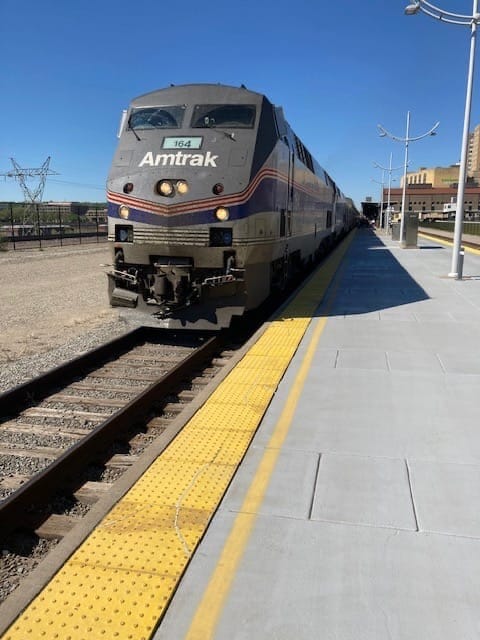Climate Train
When traveling what is the "best" climate change choice?

When I was young my Dad listened to railroad songs, a unique genre of music, much of it produced during the Great Depression when poverty caused people to “ride the rails”, jumping on empty box cars to get around the country for free. My Dad's favourite artist was Cisco Houston, who helped popularize this music. (Check out the Smithsonian Folkways recording of Hobo Bill.)
For those unfamiliar with it, think of railroad music as similar to traditional country music, but instead of heartbreak and sadness, railroad music more frequently dealt—often graphically—with death and violence. You can understand the fascination this would hold for a young boy.
Fascination with trains has stayed with me through to today. So it was with some excitement that I recently had occasion to take a train trip. The trip was precipitated by my father-in-law’s wish to visit his sisters in Kentucky, and to get there by rail. Air travel would’ve been the natural alternative from a speed and convenience perspective, but despite some gentle cajoling along those lines, my father-in-law stuck with his decision, so train it was.
We booked passage on the AMTRAK “Empire Builder” from Seattle to Chicago.1 The trip takes just under 48 hours and involves two nights on board. We booked sleeper accommodations, with seats that folded out to become bunk beds, a private bathroom with a shower, a window, and a fold-down table. All in a space of approximately 7 ft square.
Not surprisingly, from an emissions perspective, it would be best to walk or ride a bicycle. But beyond that, the emissions rankings become surprisingly complex.
The train we rode was powered by a General Electric diesel-electric locomotive producing 4,250 horsepower from a V16 diesel engine. These legacy engines are still used on this route, although newer Siemens locomotives (such as the ALC-42) are more efficient, albeit with similar base specifications. The top speed is 110 mph, though most of the route is limited to 79 mph (127 km/h). Our average speed was around 50 mph (80 km/h). The train had two engines—the second one to provide extra power on steep grades and redundancy in case of failure of the main engine.
Power from the engine is converted to AC power via an alternator and then runs through a rectifier to convert it to DC power that in turn drives the DC traction motors attached to each axle of the engine, hence "diesel-electric". Electric drive allows for precise torque control and is especially helpful in starting a heavy train, as electric motors deliver maximum torque from zero RPM (revolutions per minute).
The engine also provides power for the non-motive requirements of the train. Think of these as the “hotel” functions such as lighting, HVAC, kitchen, and passenger outlets, via a system known as Head-End Power (HEP). This 480V AC power runs through the train to supply the cars. Because the engine must keep running to provide HEP even when stationary, trains can be surprisingly loud at stations.
Braking combines traditional air brakes with dynamic (electrical resistive) braking. The traction motors reverse, becoming generators. Since these trains have no onboard batteries, the electricity is dissipated through resistor grids as heat and expelled by cooling fans.
Outside North America, most passenger trains are electric, drawing power from an overhead catenary system—typically 15,000–25,000 volts AC. A pantograph mounted on the roof maintains contact with the wire, delivering power to a transformer, which steps it down to 600–1,500 volts for onboard systems. This power is then split for traction and hotel loads, usually converted into three-phase variable-frequency AC to enable precise speed control.
So, from a climate perspective, which is best?
It turns out not as simple an answer as we expected. The assumptions made for various studies had a significant impact on the results. Parsing the assumptions to get good comparisons was very complicated. That said, the results noted here are good comparison on the climate impacts of each mode.
Our approach was to look at life-cycle assessments (LCA), which consider the total emissions from cradle to grave: material extraction, manufacturing, operation, and end-of-life disposal.
Embodied Emissions
These are the emissions from building the train. Whether diesel or electric, embodied emissions are surprisingly similar—about 30 grams CO2e (carbon dioxide equivalent) per passenger-km over the vehicle’s lifespan, assuming typical usage levels.
That said, manufacturing emissions depend on the local grid. Older GE locomotives were built in Pennsylvania, where electricity was mostly coal and gas. The newer Siemens models are assembled in Sacramento, California—where the grid is substantially greener.
Operational Emissions
Here, the difference is more dramatic. Diesel trains emit around 70–100 g CO2e/passenger-km in operation, depending on load factor. Electric trains vary more, based on grid cleanliness:2
- On clean grids (e.g. France or California), emissions can be as low as 30–50 g CO2e/passenger-km.
- On coal-heavy grids (e.g. India or parts of China), emissions can spike to 150 g CO2e/passenger-km.
By contrast, airplanes emit between 120–250 g CO2e/passenger-km, and passenger cars (gasoline) emit between 170–210 g CO2e/passenger-km. These values are heavily dependent on vehicle type, distance, and passenger loads. For example, if you add a person to the passenger car you halve the emissions per passenger-km.3, 4
But how was the trip?
Without turning this into a travelogue: the experience felt like a throwback to another era. The ride was rough—requiring constant bracing due to the motion. The noise was pervasive, with clanking, horns, and rail crossing bells interrupting any rhythm.
The train felt slow. Freight companies own most U.S. tracks, and AMTRAK leases access. As a result, passenger trains often stop to allow freight priority, creating frustrating delays.
Our sleeper car was clean but felt dated—somewhere between retro and shabby. Despite the nostalgia, we probably wouldn’t take this journey again by choice.
Still, as my father-in-law said, “It’s better than walking.”
Readings:
- “Empire Builder Train | Amtrak.” Accessed May 29, 2025. https://www.amtrak.com/empire-builder-train.
- Miller, C. Andrew. “Savings in Per-Passenger CO2 Emissions Using Rail Rather than Air Travel in the Northeastern U.S.” Journal of the Air & Waste Management Association 71, no. 12 (December 2, 2021): 1458–71. https://doi.org/10.1080/10962247.2020.1837996.
- “Bus, train, car or e-scooter: carbon emissions of transport modes ranked.” Accessed May 29, 2025. https://www.navit.com/resources/bus-train-car-or-e-scooter-carbon-emissions-of-transport-modes-ranked.
- Katwala, Amit. “Is Holidaying by Train Really That Much Better for the Environment?” Wired. Accessed May 29, 2025. https://www.wired.com/story/trains-planes-emissions-co2-comparison/.
